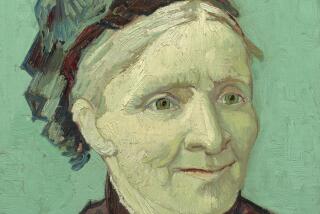Lasting Impressions of an Artists’ Colony
- Share via
OLD LYME, Conn. — Welcome to Florence Griswold’s boarding house, one of America’s most unusual art treasures. Beneath the grand portico, this 1817 yellow mansion houses one of the world’s finest collections of American Impressionist painting.
The works were created by artists who summered in Miss Florence’s Boarding House from 1899 to the mid-1920s, when the 15-room home was the center of the American Impressionist movement.
In 1841, Robert Griswold, a sea captain, bought the stately home for his bride. But at the time of his death in 1882, he had lost his fortune, and his widow and daughters started a finishing school in the house.
In 1899, the surviving daughter, Florence, converted the mansion into a boarding house for artists after Henry Ward Ranger came to town and told her of his plans to launch an art colony.
Ranger, a well-known artist at the time, spread the word through the New York art community about this picturesque village, the beautiful seashore nearby and the surrounding rural countryside. And he did not forget to mention Florence Griswold’s boarding house as the perfect place for artists to stay.
The boarding house became an instant mecca for some of the nation’s best-known artists. They set up their studios in barns on Griswold property overlooking the Lieutenant River. They painted outdoors, using as backgrounds the historic town buildings, the river, the gardens, the meadows, an old cemetery and the woods. Will Howe, who often painted bucolic scenes, even rented cows as models from a local dairy farm. When they weren’t painting, the artists canoed, pitched horseshoes or played baseball.
The painters shared a common table in the dining room of the boarding house. Florence Griswold, they said, served the best meals in the state. After dinner she often played her harp, with some of the artists joining her in impromptu musical programs.
Florence sold their paintings from a hallway gallery. When the artists fell on hard times, she loaned them money. It is said that she never charged enough for room and board.
The artists reciprocated by painting on hallway, parlor and dining room doors and walls. The boarding house contains 40 such works. On the dining room mantel, the artists did caricatures of themselves--a lasting memorial to their personalities and esprit de corps.
During the time he served as president of Princeton University, Woodrow Wilson and his wife, an artist, stayed at the boarding house on several occasions. Later, he wrote Florence from the White House:
“Mrs. Wilson and I think very, very often of our happy days with you in Lyme. . . .”
At summer’s end, the artists’ works were exhibited and sold at the Old Lyme library, where several Impressionist paintings still hang in a permanent exhibit. In Old Lyme Town Hall are 20 paintings from the colony’s heyday.
The Lyme Art Assn., established in 1914, moved into its own gallery on land donated by Florence Griswold in 1921, making it the first artist-owned and -operated gallery in the United States.
The American Impressionist period ended in the mid-1920s, but Old Lyme continues as an art center; today the village is home to painters, sculptors, poets and writers. And local artists still run the Lyme Art Assn. Gallery, where only the work of members, many of them nationally known, is for sale. William Babcock, 75, a painter of seascapes, has been association president for the past six years.
“The entire village is identified with art. Local residents are very supportive of artists,” said Jennifer Christie, 20, of Marysville, Calif. She is one of more than 200 students from around the nation who study at sculptor Elizabeth Gordon Chandler’s Lyme Academy of Fine Arts. Her father, Keith Christie, is a Western artist.
Artists continued to stay in the boarding house until 1937, when Florence Griswold died at age 87. Before her death, her artist friends formed an association to care for her and to maintain her house as a museum. In 1955, the Florence Griswold Museum became part of the Lyme Historical Society.
“Its purpose is to interpret and promote the legacy of the Lyme art colony,” explained Jeffrey Andersen, 37, museum director.
In its permanent collection the historical society has more than 900 paintings, drawings, watercolors and prints, including such famous works as George Burr’s 1914 “Summer Garden,” William Chadwick’s 1908 “On the Porch” and Will Howe Foote’s 1906 “A Summer’s Night,” a haunting painting of a woman at the door of the boarding house.
More to Read
The biggest entertainment stories
Get our big stories about Hollywood, film, television, music, arts, culture and more right in your inbox as soon as they publish.
You may occasionally receive promotional content from the Los Angeles Times.










